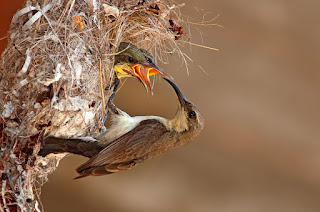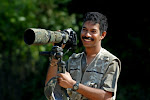गेल्या वर्षी
दिवाळीच्या सुट्टीमधे मेघालयला जायचा योग आला. चेरापुंजी, शिलॉंग, रूट ब्रिज अश्या
प्रसिद्ध ठिकाणांना भेट दिली. या ठिकाणी फिरताना तिथला आगळा वेगळा स्वच्छ निसर्ग
बघताना वेगळीच मजा येत होती. त्याच वेळी निर्णय घेतला की पुढच्या वर्षी बरेच दिवस
मनात घोळत असलेली गारो हिल्सची सफर खास तिथल्या फुलपाखरांकरता करायची.
आता मेघालयाचा चेरापुंजी,
शिलॉंग हया भागात अनेक प्रवासी येत असल्यामुळे इथे बरीच हॉटेल्स आणि अनेक सुखसोयी
आहेत. मात्र गारो हिल्स हा भाग मात्र अगदिच अविकसीत असल्यामुळे इथे येण्याकरता खास
नियोजन करावा लागते. स्थानीक लोकांच्या विकासासाठी झटणारी संरक्षण संस्था यांच्या
सहयोगाने इथली व्यवस्था केली. मेघालय मधे गारो, खासी आणि जयंती पर्वतरांगा आहेत या
मधले गारो हे सर्वात अविकसीत आहेत पण त्याच मुळे इथला निसर्ग अजूनही टिकून आहे.
फुलपाखरांच्या अनेक जाती इथे दिसत असल्यामुळे देशभरातले फुलपाखरांवर काम करणारे
निसर्गेप्रेमी इथे भेटी देतात. भारतात फुलपाखरे बघण्याचे दोन हंगाम असतात..एक तर
एप्रिल मधे तुम्ही मोठ्या प्रमाणात फुलपाखरे बघू शकता किंवा ऑक्टोबर /
नोव्हेंबरच्या काळात तुम्ही मोठ्या प्रमाणावर फुलपाखरे बघू शकता. आम्ही सुद्धा
नोव्हेंबर मधे दिवाळीच्या नंतर इथे जायचे ठरवले. ९ दिवसांच्या या फुलपाखरांच्या
शोधमोहिमेसाठी सिजू, कारवानी आणि बालपाक्रम या ठिकाणांचा समावेश केला.
सकाळी १० च्या
सुमारास आम्ही गौहाटी विमानतळावरून गारो हिल्सला जाण्याकरता सुमो जीपमधून प्रवास
सुरू केला. साधारणत: ६ ते ७ तासाचा हा प्रवास असणार होता. गौहाटी शहराच्या
गजबजाटातून बाहेर पडायला वेळ लागला आणि त्यानंतर आम्ही शहराच्या बाहेर मेघायलाला
जोडणाऱ्या हायवेला लागलो. मध्येच एका धाब्यावर जेवाण उरकून घेतले आणि पुढचा प्रवास
सुरु केला. हळूहळू आम्ही शहारापासून दूर जायला लागलो आणि तिथला निसर्ग जाणवायला
लागला. दूर दूर पर्यंत पसरलेल्या भातशेती आणि पलीकडचे हिरवेगार डोंगर नजरेला सुखद
थंडावा देत होते. आसाम मधे असे पर्यंत रस्ते सरळ आणि गुळगुळीत होते. मात्र आता
आम्ही मेघालय मधे शिरलो होतो आणि सिजू गावाकडे चाललो होतो. हळूहळू डांबरी रस्ता
नाहिसा व्हायला लागला आणि मातीच्या कच्च्या रस्त्यावरून आमचा प्रवास अगदी संथ
वेगाने व्हायला लागला. मुळात मातीचा रस्ता आणि त्यात प्रचंड मोठी खड्डे. मुळातच
देशाच्या पुर्वेला असल्यामुळे इथे दिवस फारच लवकर मावळत असतो. त्यामुळे अंधार
पडायला लागला आणि आम्हि एका गावाच्या जवळ पोहोचलो. सोबतच्या गुगल मॅप्सवर हेच सिजू
गाव आहे असे दाखवत होते. गावाच्या मुख्य चौकात सर्वत्र संत्री विकायला ठेवली होती.
आम्ही आपले मनात विचार करत होतो की कशी काय ही संत्री पार नागपूर पासून इथपर्यंत
विकायला आली ? त्यानंतर आम्हाला कळले की सिजू इथली संत्रीसुद्धा आपल्या नागपूर
सारखीच प्रसिद्ध आहेत आणि अगदी थेट शेजारच्या बांगलादेशामध्येसुद्धा पाठवली
जाताअत. नंतर गडद अंधारात आम्ही आमच्या वाटाड्याला कसेबसे शोधले आणि त्याच्या
मागोमाग आम्ही परत पुढे जायला निघालो. गावापासून बरेच लांब आणि वळणा वळणाच्या
रस्तावरून आम्ही एका ठिकाणी जीप थांबवली आणि तिथे आमचे सामान उतरवून घेतले. त्या
सिजू गावच्या आधीच आमच्या मोबाईलची रेंज मेली होती. आमचे सामान एका इमारतीपर्यंत
आणल्यावर, आम्हाला आमच्या खोल्या दाखवल्या. दिवसभराच्या प्रवासानंतर थकलेल्या
आम्हाला नविन धक्का बसला... इथे विजच नाही. त्यामुळे आता प्रत्येक गोष्ट टॉर्चच्या
प्रकाशात करायची, म्हणजे अगदी हातपाय धुण्यापासून ते बॅगेतून सामान शोधेपर्यंत.
चहा मिळेल का ? असे विचारल्यावर त्यांनी विचित्र नजरेने आम्हाला बघितले पण अगदी १०
मिनिटातच बिनदूधाचा चहा आम्हाला दिला. चहाचा कप आम्ही खाली ठेवला आणि त्यांनी
आम्हाला सांगीतले जेवण तयार आहे. त्यांच्या विचित्र नजरेचा अर्थ आत्ता आम्हाला
समजला. संध्याकाळचे फक्त ६ वाजले होते, त्यांना गावात परत जायचे होते म्हणून
त्यांनी आमचे जेवण तयार करून त्या निघून गेल्या. मिट्ट काळोखात, फक्त ६ वाजता
आम्ही जेवलो आणि चक्क ७ वाजता बळजबरी झोपायला गेलो कारण अर्थातच आम्हाला करायला काहीच
नव्हते.
भल्या पहाटे बिन
पंख्याच्या नैसर्गिक गारठ्याने आणि पक्ष्यांच्या सुरेल गायनानेच जाग आली.
खिडकीच्या बाहेर नजर टाकली आणि एकदम मंत्रमुग्ध होऊन गेलो. आमच्या घराच्या पलिकडे
पांढऱ्या शुभ्र वाळूचा किनारा होता आणि त्यानंतर नितळ पाण्यानी संथ वाहणारी
नदी...नदीच्या पलीकडच्या काठावर हिरवाकंच डोंगर. याच डोंगरावर पक्ष्यांचा किलबीलाट
सुरू होता. आम्हीसुद्धा आमचे कॅमेरे सज्ज केले आणि त्यांची छायाचित्रे टिपायचा
प्रयत्न केला. यानंतर आम्ही नाश्ता करून सिजूच्या जंगालात फुलपाखरे बघायला निघालो.
नदीवरचा तारेचा डगमगता पूल पार करून आम्ही पलिकडच्या जंगलात शिरलो. याच घनदाट
जंगालामधे आता आम्हाला फुलपाखरे शोधायची होती. एकेक फुलपाखराची जात शोधत शोधत,
त्यांचे जमेल तसे छायाचित्रण करत आम्ही पुढे निघालो. एका सुकलेल्या ओढ्यामधे आम्ही
त्याच्या उगमाच्या दिशेने निघालो. मोठमोठाले दगड कसेबसे पार करत, स्वत:ला आणि
आमच्यापेक्षा उरावरच्या कॅमेराला सांभाळताना आमची त्रेधातिरपीट उड्त होती, आमचा
वाटाड्या मात्र टणाट्ण उड्या मारत पुढे सरकत होता. याच ओढ्यातून पार होताना मधेच
आम्हाला किटकभक्षी घटपर्णी वेली दिसत होत्या, काही ठिकाणी नुकतेच हत्तीच्या
पावलांचे ठसे दिसत होते. मधेमधे वेगवेगळ्या जातीची फुलपाखरे दिसत होती. ४/५ तास
तंगडतोड झाल्यावर आम्ही परत फिरायला लागलो.
या वेळी
वाटाड्याबरोबर गप्पा मारताना, दुर्मिळ फुलपाखरांचा विषय निघाला आणि त्याने
सांगितले की या जंगलाच्या भागात कोहिनूर हे अतिशय दुर्मिळ फुलपाखरू सापडते. आमच्या
गप्पा सुरु असतानाच एक भलेमोठे जवळपास पंजाच्या आकाराचे झळाळत्या निळ्या रंगाचे
फुलपाखरू उडत पुढे गेले. आमचा वाटाड्या जोरात ओरडला “कोहिनूर........” आम्हा
पायवाट सोडून आत घनदाट जंगलात त्याच्यामागे पळत निघालो. ते फुलपाखरू सुद्धा
आम्हाला झुलवत झुलवत थोडे पुढे उडायचे.. मधेच बसायचे...परत थोडे उडायचे आणि मग परत
बसायचे. त्याच्या मागे खड्ड्यातून, नदितून पळता पळता आम्हाला त्याची
छायाचित्रेसुद्ध मिळत होती. त्याला नजरेत आणि कॅमेरातसुद्धा साठवून आम्ही पुढच्या
प्रवासाला निघालो. आता आम्हाला सिजूहून कारवानीच्या जंगलासाठी जायचे होते. तसे हे
अंतर जेमतेम ३०/३५ किलोमीटर होते पण तिथे रस्ता नसून फक्त मोठे मोठे न टाळता
येण्यासारखे खड्डे असल्यामुळे ज्या प्रवासाला एक तास लागायला हवा होता त्यासाठी
आम्हाला साडेतीन तास लागले. परत एकदा दिवस लवकर मावळला होता. आम्ही रस्त्याच्या
कडेला गाडी लावली आणि सामान उतरवून खाली ठेवले. रस्त्याच्या कडेला खाली उतारानंतर
एक छोटासा ओढा होता आणि त्यावर दोन बांबू टाकले होते. त्या बांबूवर आमचा तोल
सांभाळत कसेबसे आम्ही पलिकडे गेलो. वाटाड्या आणि त्या घरातला मुलगा मात्र
सराईतासारखे आमच्या सामानासकट पलिकडे गेले. या ठिकाणी चक्क विज होती आणि अधेमधे
मोबाईला रेंजसुद्धा, म्हणजे आमची चंगळच होती. धडाधड कॅमेराच्या बॅटऱ्या, मोबाईल
चार्जींगला लावले. होम स्टे मधले आदरातिथ्य आणि अतिशय रूचकर जेवणाचा आस्वाद घेउन
परत आम्ही संध्याकाळी ७ च्या सुमारसच गादीवर प्रवासात खिळखिळे झालेले शरीर झोकून
दिले.
दुसऱ्या दिवशी
सकाळी लवकर उठून परत एकदा अतिशय रूचकर असा नाश्ता करून आम्ही जंगलात जायला सज्ज
झालो. आद्ल्या दिवशी सिजूला ८५ फुलपाखरांच्या जाती बघितल्यामुळे इथल्या जंगलात आता
कुठल्या नविन जाती सापडणार याची उत्सुकता मोठी होती. कारवानीच्या झऱ्याच्या
काठाकाठाने आम्ही जंगालात फिरत होतो.... फुलपाखरांच्या नविन नविन जाती दिसत होत्या
पण अर्थातच नविन जाती दिसण्याचे प्रमाण आता कमी कमी होत होते कारण १०० पेक्षा
जास्त जाती आता आम्ही बघितल्या होत्या. त्यांची आता जास्तीत जास्त चांगली
छायाचित्रे मिळवण्याचा आमचा प्रयत्न सुरू होता. दिवस मावळत आला होता आणि आम्ही परत
आमच्या होम स्टे मधे परतलो. रस्त्यामधे आम्हाला आमच्या वाटाड्याने एका जागी ड्रॉसेरा
बर्मानी ही किटकभक्षी जात दाखवली. गुलाबी रंगाचे
एखाद्या गुलाबाच्या फुलासारखे दिसणारे, जेमतेम २ रुपयाच्या नाण्याएवढेच असणारे झाड,
आजूबाजूला जाण्याऱ्या मुंगी आणि इतर किटकांचे भक्षण करत असताना दिसले. दिवस मावळत
असल्यामुळे त्यांचे छायाचित्रण न करता परत सकाळी लवकर येउन त्यांचे छायाचित्रण
करून पुढे जायचे ठरवले. परत एकदा होम स्टे मधे परतलो, आता आम्ही सुद्धा त्या
ओहोळावरच्या बांबूवरून लिलया पार होत होतो. रात्री बांबूच्या कोवळ्या कोंबांची
शेकोटीत भाजलेली भाजी आणि गरम गरम कंदमुळे यावर ताव मारला.
सकाळी लवकर उठून
ड्रॉसेरा बर्मानी ह्या किटकभक्षी
वनस्पतीचे छायाचित्रण करून आम्ही आमच्या शेवटच्या मुक्कामाच्या ठिकाणी निघालो. मधे
मधे थांबत, पक्षीनिरिक्षण करत आम्ही संध्याकाळी बालपाक्रम जंगलाच्या वनविभागाच्या
रेस्ट हाउस वर पोहोचलो. एक प्रचंड मोठा आणि सुसज्ज बंगला आम्हाला देण्यात आला. या
भागात मातृसत्ताक पद्धती असल्यामुळे आतापर्यंत सर्वत्र बायकाच आमचे जेवण बनवणे,
शेती करणे, दुकाने चालवणे आणि इतर कामधंदे करणे अशी प्रमुख कामे करतात. घरातसुद्धा
एकंदर मुलांमधे एकच मुलगी घरी राहून घराची आणि आई-बाबांची काळजी घेते तर इतर मुली
आणि मुलांना घराबाहेर पडून त्यांची त्यांची स्वतंत्र व्यवस्था बघावी लागते. इथे
आमची जेवण करण्यासाठी दोन लहान दिसणाऱया मुली खानसामा म्हणून होत्या आणि जेमतेम
शाळकरी दिसणाऱ्या त्या मुलींपैकी एका बहिणीचे लग्नसुद्धा झाले होते हा आमच्या करता
मोठा धक्काच होता. इथे सुद्धा संध्याकाळी लवक्र जेउन आम्ही झोपी गेलो.
सकाळी लवकर उठून
आम्ही बालपाक्रम राष्ट्रिय उद्यानात जायला निघालो. मधे मधे पक्षी, फुलापाखरे बघत
आम्ही जंगलात वेगवेगळ्या भागात फिरत होतो. आता आमचा फुलपाखरांचा काऊंट १५० च्या
पुढे गेला होता. जंगलात दिवसभर फिरून परत येत असताना मला एका झाडावर अनेक फुलपाखरे
दिसली. मी जीप थांबवायला सांगीतली आणि बरोबरच्या मित्रांना ती फुलपाखरे दाखवली. एका
छोट्याश्या झुडपावर १००/१५० फुलपाखरे स्थिरावली होती. आधी सर्वांना ती फुलपाखरे
गाडीतूनच बघायला सांगीतली आणि तिथूनच त्यांचे थोडे छायाचित्रण केले. मग अलगद
गाडीतून उतरून त्यांच्य जवळ जाउन त्यांचे निरिक्षण केले तेव्हा कळले की ती रेड
स्पॉट जझबेल जातीची फुलपाखरे होती आणि जवळपास १५० फुलपाखरे एकाच वेळेला कोषातून
बाहेर येऊन त्यांचे ओले पंख त्या झाडाच्या फांद्यांवर वाळवत होती. एक छोटेसे
जेमतेम २/३ फुट उंचीचे झुडूप आणि त्यावर लगडलेली १५० संथपणे हलणारी फुलपाखरे बघणे
म्हणजे आनंदाची परिसीमा होती. जवळच्या कॅमेराने त्या फुलपाखरांची छायाचित्रे,
विडीओ घेतली अगदी मोबाईलनेसुद्धा त्यांचे छायाचित्रण केले. प्रसन्न मनाने आम्ही
आमच्या परतीच्या प्रवासाला निघालो. प्रत्येक रस्तावर दिसणारा निसर्ग मनात साठवत,
तसाच खडतर प्रवास आम्ही मजल दरमजल करत पार केला. परतीच्या प्रवासात परत आमच्या मुक्काम
त्याच कारवानीच्या होम स्टे मधे आणि त्यानंतर सिजू इथे होता. या परतीच्या वेळेस
आम्ही सिजू इथेली प्राचिन गुहा बघायला गेलो. अतिशय खोल आणि मोठी असणारी ही गुहा
आणि त्यात थंडगार पाण्याचे ओहोळ, त्यात दिसणारे बेडूक आणि कोलंब्या यांचे
छायाचित्रण करून आम्ही परतलो. सकाळी आमचा परतीचा शेवटचा प्रवास सुरू झाला... खड्या
खड्यांच्या रस्त्यावरून आम्ही परत आसामच्या सरळ आणि गुळगुळीत रस्त्याला लागलो,
मात्र मनात अजूनही मेघालयातला निसर्गच आठवत होता... या निसर्गरम्य आठवणी आठवतच
आम्ही परत आलो ते पावसाळ्यानंतर परत लगेचच हिरवाकंच, ओला मेघालय बघायचा ते ठरवूनच.
युवराज गुर्जर.
www.yuwarajgurjar.com





















































